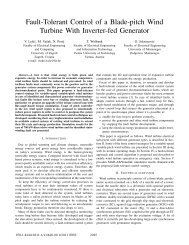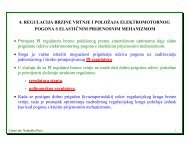Damping of Wind Turbine Tower Oscillations through Rotor Speed ...
Damping of Wind Turbine Tower Oscillations through Rotor Speed ...
Damping of Wind Turbine Tower Oscillations through Rotor Speed ...
Create successful ePaper yourself
Turn your PDF publications into a flip-book with our unique Google optimized e-Paper software.
Pitch angle [deg]<br />
16<br />
15<br />
14<br />
13<br />
12<br />
11<br />
10<br />
9<br />
8<br />
7<br />
0 10 20 30 40 50 60 70<br />
t [s]<br />
Figure 14: Response <strong>of</strong> pitch angle <strong>of</strong> the system<br />
controlled with full state feedback controller.<br />
<strong>Tower</strong> top displacement [m]<br />
0.12<br />
0.1<br />
0.08<br />
0.06<br />
0.04<br />
0.02<br />
0<br />
-0.02<br />
-0.04<br />
0 10 20 30 40 50 60 70<br />
t [s]<br />
Figure 15: Response <strong>of</strong> tower top displacement <strong>of</strong><br />
the system controlled with full state feedback<br />
controller.<br />
using Kaimal spectrum recommended by the<br />
international standards for wind turbine design<br />
[8]. To gain valid information about system<br />
behavior in 3D turbulent conditions it is<br />
necessary for the simulations to last for at least<br />
10 minutes what generates lots <strong>of</strong> data.<br />
Therefore, simulation results are not presented<br />
here due to limited space. Simulations in 3D<br />
turbulent wind field have shown that inputoutput<br />
pole placement controller in turbulent<br />
conditions achieves only modest improvement <strong>of</strong><br />
tower oscillations when compared to the PID<br />
controller. The reason for this is the mentioned<br />
fact that input-output controller doesn't use<br />
information about actual tower oscillations. On<br />
the other hand full state feedback controller<br />
maintains shown ability to reduce tower<br />
oscillations even under turbulent winds. The cost<br />
<strong>of</strong> that is increased pitch activity what must be<br />
taken into account to avoid pitch system<br />
excessive wear. Simple design method proposed<br />
in this paper makes it possible to easily change<br />
the desired increase in tower damping and to<br />
achieve a trade<strong>of</strong>f between reduction <strong>of</strong> tower<br />
oscillations and increase <strong>of</strong> pitch activity.<br />
7. Conclusion<br />
The control system for variable speed pitch<br />
controlled wind turbine is presented. The wind<br />
turbine system is highly nonlinear and its<br />
parameters change significantly with change <strong>of</strong><br />
wind speed. Furthermore wind turbine<br />
mechanical structure is very flexible and can<br />
easily be driven into oscillatory behavior. All<br />
this makes the controller design a very<br />
demanding task. In this paper three methods<br />
for wind turbine pitch controller design are<br />
compared. It is shown that classic PID<br />
controller can assure good rotor speed<br />
regulation but tower oscillations are very<br />
pronounced. To reduce these undesired<br />
oscillations two alternative control structures<br />
are investigated: input-output pole placement<br />
controller and full state feedback controller.<br />
The design objective for these controllers,<br />
besides good rotor speed regulation, was the<br />
increase <strong>of</strong> tower damping. Both controllers<br />
have shown that owing to increased pitch<br />
control activity it becomes possible to damp<br />
the tower oscillations. To test the controllers'<br />
performances in more realistic conditions<br />
simulation under 3D turbulent wind field were<br />
conducted in Bladed. It was observed that<br />
under such conditions only slight reduction <strong>of</strong><br />
tower oscillations is achieved by input-output<br />
pole placement controller. On the other hand<br />
full state feedback controller has shown that is<br />
capable <strong>of</strong> reducing the tower oscillations even<br />
under turbulent conditions. The achieved<br />
damping <strong>of</strong> tower oscillations leads to fatigue<br />
reduction what enables production <strong>of</strong> lighter<br />
and less expensive wind turbines. This can<br />
result in reduction <strong>of</strong> the price for electrical<br />
energy generated by wind turbines.<br />
Acknowledgements<br />
This work was financially supported by Končar –<br />
Electrical Engineering Institute and the Ministry <strong>of</strong><br />
Science Education and Sports <strong>of</strong> the Republic <strong>of</strong><br />
Croatia.<br />
References<br />
[1] T. Burton, D. Sharpe, N. Jenkins, E.<br />
Bossanyi, "<strong>Wind</strong> energy handbook," John<br />
Wiley and sons, 2001.<br />
[2] P. Novak, T. Ekelund, I. Jovik and B.<br />
Schmidtbauer, "Modeling and control <strong>of</strong><br />
variable-speed wind-turbine drive-system<br />
dynamics," Control system magazine, Vol.<br />
15, No. 4, pp. 28-38, 1995.







